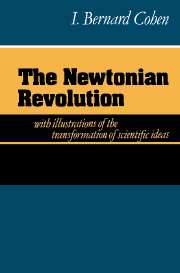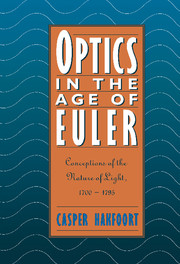Refine search
Actions for selected content:
13588 results in History of science and technology
Jagdish N. Sinha, Science, War and Imperialism: India in the Second World War.Leiden and Boston: Brill, 2008. Pp. xiv+278. ISBN 978-90-04-16645-5. €79.00 (paperback). - Itty Abraham (ed.), South Asian Cultures of the Bomb: Atomic Publics and the State in India and Pakistan. Bloomington: Indiana University Press, 2009. Pp. ix+222. ISBN 978-0-253-22032-5. $24.95 (paperback).
-
- Journal:
- The British Journal for the History of Science / Volume 43 / Issue 2 / June 2010
- Published online by Cambridge University Press:
- 14 June 2010, pp. 285-286
- Print publication:
- June 2010
-
- Article
- Export citation
Daryn Lehoux, Astronomy, Weather, and Calendars in the Ancient World: Parapegmata and Related Texts in Classical and Ancient Near Eastern Societies. Cambridge and New York: Cambridge University Press, 2007. Pp. xiv+566. ISBN 978-0-521-85181-7. £65.00 (hardback).
-
- Journal:
- The British Journal for the History of Science / Volume 43 / Issue 2 / June 2010
- Published online by Cambridge University Press:
- 14 June 2010, pp. 288-289
- Print publication:
- June 2010
-
- Article
- Export citation
Helaine Selin (ed.), Encyclopaedia of the History of Science, Technology, and Medicine in Non-Western Cultures, Second Edition. 2 vols. Berlin, Heidelberg and New York: Springer, 2008. Pp. xix+2416. ISBN 978-1-4020-4559-2. £355.00 (hardback).
-
- Journal:
- The British Journal for the History of Science / Volume 43 / Issue 2 / June 2010
- Published online by Cambridge University Press:
- 14 June 2010, pp. 284-285
- Print publication:
- June 2010
-
- Article
- Export citation
BJH volume 43 issue 2 Cover and Front matter
-
- Journal:
- The British Journal for the History of Science / Volume 43 / Issue 2 / June 2010
- Published online by Cambridge University Press:
- 14 June 2010, pp. f1-f2
- Print publication:
- June 2010
-
- Article
-
- You have access
- Export citation
BJH volume 43 issue 2 Cover and Back matter
-
- Journal:
- The British Journal for the History of Science / Volume 43 / Issue 2 / June 2010
- Published online by Cambridge University Press:
- 14 June 2010, pp. b1-b9
- Print publication:
- June 2010
-
- Article
-
- You have access
- Export citation
John Holmes, Darwin's Bards: British and American Poetry in the Age of Evolution. Edinburgh: Edinburgh University Press, 2009. Pp. xiv+288. ISBN 978-0-7486-3940-3. £60.00 (hardback).
-
- Journal:
- The British Journal for the History of Science / Volume 43 / Issue 2 / June 2010
- Published online by Cambridge University Press:
- 14 June 2010, pp. 305-306
- Print publication:
- June 2010
-
- Article
- Export citation
Michael Lynch, Simon A. Cole, Ruth McNally and Kathleen Jordan, Truth Machine: The Contentious History of DNA Fingerprinting. Chicago and London: University of Chicago Press, 2009. Pp. xxii+389. ISBN 978-0-226-49806-5. £22.00 (hardback).
-
- Journal:
- The British Journal for the History of Science / Volume 43 / Issue 2 / June 2010
- Published online by Cambridge University Press:
- 14 June 2010, pp. 319-320
- Print publication:
- June 2010
-
- Article
- Export citation
Robert Bartlett, The Natural and the Supernatural in the Middle Ages. Cambridge: Cambridge University Press, 2008. Pp. x+170. ISBN 978-0-521-70255-3. £17.99.
-
- Journal:
- The British Journal for the History of Science / Volume 43 / Issue 2 / June 2010
- Published online by Cambridge University Press:
- 14 June 2010, pp. 291-292
- Print publication:
- June 2010
-
- Article
- Export citation
G. Richard Delisle, Les Philosophies du néo-darwinisme. Preface by Jean Gayon. Paris: Presses universitaires France, 2009. Pp. 456. ISBN 978-2130566267. Canadian $56.70 (paperback).
-
- Journal:
- The British Journal for the History of Science / Volume 43 / Issue 2 / June 2010
- Published online by Cambridge University Press:
- 14 June 2010, pp. 315-317
- Print publication:
- June 2010
-
- Article
- Export citation
Denise Gigante, Life: Organic Form and Romanticism. New Haven and London: Yale University Press, 2009. Pp. xiii+302. ISBN 978-0-300-13685-2. £27.95 (hardback).
-
- Journal:
- The British Journal for the History of Science / Volume 43 / Issue 2 / June 2010
- Published online by Cambridge University Press:
- 14 June 2010, pp. 303-305
- Print publication:
- June 2010
-
- Article
- Export citation
Laura Dassow Walls, The Passage to Cosmos: Alexander von Humboldt and the Shaping of America. Chicago and London: University of Chicago Press, 2009. Pp. xv+404. ISBN 978-0-226-87182-0. £24.00 (hardback). - H. Walter Lack, Alexander von Humboldt and the Botanical Exploration of the Americas. London: Prestel, 2009. Pp. 278. ISBN 978-3-79134142-2. £125.00 (hardback).
-
- Journal:
- The British Journal for the History of Science / Volume 43 / Issue 2 / June 2010
- Published online by Cambridge University Press:
- 14 June 2010, pp. 302-303
- Print publication:
- June 2010
-
- Article
- Export citation
Anne Harrington, The Cure Within: A History of Mind–Body Medicine. New York and London: W.W. Norton & Company, 2008. Pp. 336. ISBN 978-0-393-06563-3. £19.99 (hardback).
-
- Journal:
- The British Journal for the History of Science / Volume 43 / Issue 2 / June 2010
- Published online by Cambridge University Press:
- 14 June 2010, pp. 320-322
- Print publication:
- June 2010
-
- Article
- Export citation
Heredity reconceived?
-
- Journal:
- The British Journal for the History of Science / Volume 43 / Issue 2 / June 2010
- Published online by Cambridge University Press:
- 14 June 2010, pp. 277-282
- Print publication:
- June 2010
-
- Article
- Export citation
Peter Ayres, The Aliveness of Plants: The Darwins at the Dawn of Plant Science. London: Pickering & Chatto, 2008. Pp. xiii+227. ISBN 978-1-85196-970-8. £60.00 (hardback). - David Kohn, Darwin's Garden: An Evolutionary Adventure. New York: New York Botanical Garden, 2008. Pp. 60. ISBN 978-0-89327-970-7. $17.99.
-
- Journal:
- The British Journal for the History of Science / Volume 43 / Issue 2 / June 2010
- Published online by Cambridge University Press:
- 14 June 2010, pp. 306-308
- Print publication:
- June 2010
-
- Article
- Export citation
Synthetic technocracy: Dutch scientific intellectuals in science, society and culture, 1880–1950
-
- Journal:
- The British Journal for the History of Science / Volume 44 / Issue 1 / March 2011
- Published online by Cambridge University Press:
- 14 May 2010, pp. 89-113
- Print publication:
- March 2011
-
- Article
- Export citation

Worse than the Disease
- Pitfalls of Medical Progress
-
- Published online:
- 05 May 2010
- Print publication:
- 24 June 1988
Stabilizing American Society: Kenneth Boulding and the Integration of the Social Sciences, 1943–1980
-
- Journal:
- Science in Context / Volume 23 / Issue 2 / June 2010
- Published online by Cambridge University Press:
- 04 May 2010, pp. 221-265
- Print publication:
- June 2010
-
- Article
- Export citation

The Newtonian Revolution
-
- Published online:
- 04 May 2010
- Print publication:
- 31 January 1981
Two Approaches to Foundations in Greek Mathematics: Apollonius and Geminus
-
- Journal:
- Science in Context / Volume 23 / Issue 2 / June 2010
- Published online by Cambridge University Press:
- 04 May 2010, pp. 151-186
- Print publication:
- June 2010
-
- Article
- Export citation

Optics in the Age of Euler
- Conceptions of the Nature of Light, 1700–1795
-
- Published online:
- 04 May 2010
- Print publication:
- 27 January 1995
